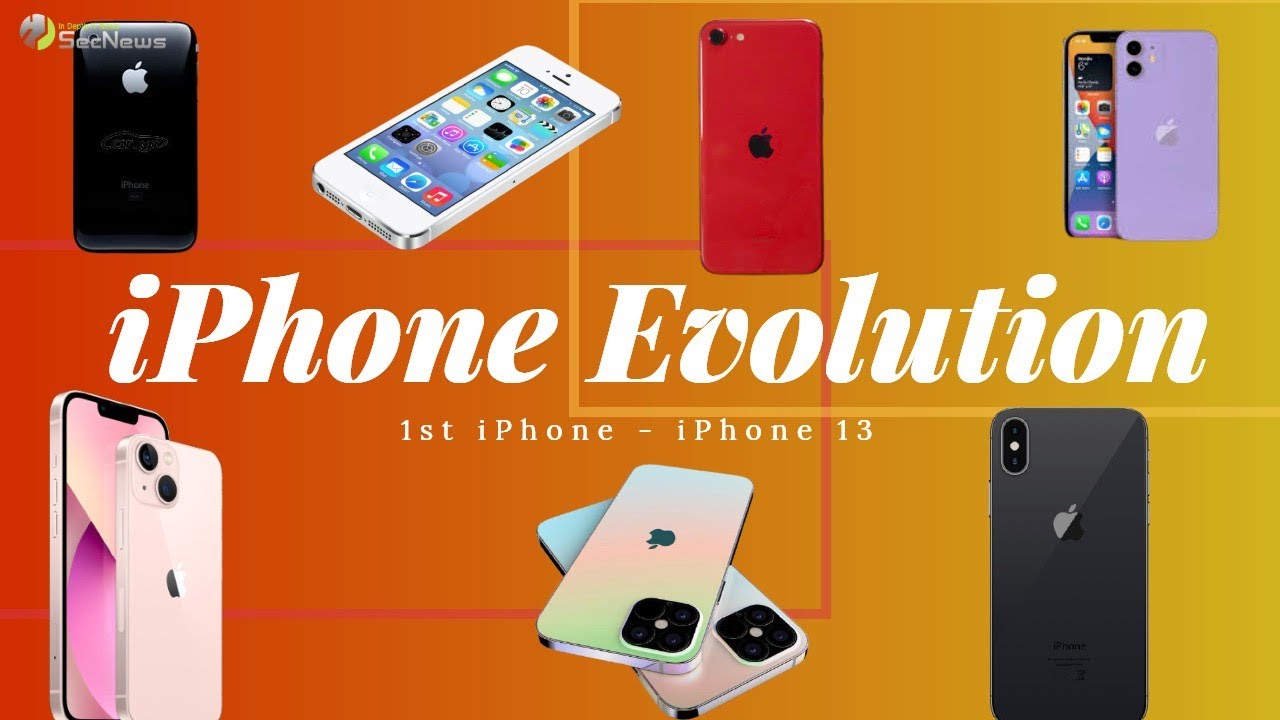The release of the new iPhone 13 model was definitely an event that many Apple fans were looking forward to. But what was the first iPhone ever released and when did it first hit the market? In this video we will see the evolution of iPhone models over the years, as well as the remarkable changes that have been made with each release. The journey of the iPhone started in 2007 and more specifically on June 29, with the first iPhone model that had a total storage space of only 16 GB. It offered internet access, with a 3.5-inch screen and weighed just 135 grams. Apple's first iPhone could handle only 128 MB of memory, and had a 2.0 megapixel camera, which was quite sophisticated for the time it was released. About a year later, on July 11, 2008, Apple released the next iPhone model, known as the iPhone 3G. In terms of internal specifications, the iPhone 3G was not much different from the original iPhone, however it had the App Store. This iPhone got its name from the 3G connectivity feature, which meant better internet access.
The iPhone 3G also weighed less, at 133 grams and had a slightly better screen resolution. On June 19, 2009, the third generation iPhone was released, with the 3GS model, which introduced the 32 GB storage option, doubling it from the first model. Clearly, the introduction of the App Store changed things very quickly. With more photos, music and apps, the 16 GB just was no longer functional and needed to be changed. The camera was also upgraded to 3 MP and the ability to record video was added, with the screen size and resolution still remaining the same. Apple has also added the Voice Control feature, an ancestor of Siri. The next Apple model was released on June 24, 2010 and the iPhone 4 was the first iPhone to have a front camera. Given that selfies have taken over the world, it seems that Apple was looking far ahead. The iPhone 4 also had a Retina display, 512 MB memory and was equipped to handle much more than the iPhone 3GS, which had only 256 MB of memory. There was a clear evolution of technology, but 32 GB was still the maximum storage space of the iPhone. It also had a 5 MP camera, with the ability to record video in 720p quality.
The iPhone 4S was released on October 14, 2011, with one of the biggest differences from the iPhone 4 being the camera, which was converted from 5 MP to 8 MP and the video recording was upgraded to 1080p. Apple also introduced the 64 GB storage option, but kept the memory at 512 MB. And of course the main innovation was the integration of the Siri voice assistant! Apple sold four million iPhone 4S units in its first week of release. The iPhone 5 was released on September 21, 2012, with Apple selling 5 million iPhone 5 units in the first week of its release.
The camera remained the same, but the memory increased to up to 1 GB. Until then, 3G was considered great, but the iPhone 5 had LTE connectivity, which meant Internet everywhere! Apple also introduced the Lightning port with the iPhone 5 and for the first time, the screen became larger, reaching 4 inches. The iPhone 5s & iPhone 5c models were released on September 20, 2013. Between the iPhone 5s and the iPhone 5c, Apple sold nine million units in its first week of release. The iPhone 5c was intended to be slightly more affordable and had a plastic case, and was available in four different colors. The iPhone 5s, on the other hand, had Touch ID, dual flash and slow motion video.
In addition, it included the M7 motion coprocessor, which opened up a whole new realm of possibilities and also helped save battery power. Next on the list are the iPhone 6 & 6 Plus, released on September 19, 2014. The internal specifications of the iPhone 6 were similar to those of the iPhone 5s. The biggest difference was that it had a significantly larger screen and offered an even larger size called the 6 Plus. The Retina display became HD and the option to get an iPhone with 128 GB of storage became available. But the size of the memory was the same and the camera did not get an upgrade to megapixel. The following year, the company released the iPhone 6s & 6s Plus, on September 19, 2015.
The 6s models changed everything, as Apple significantly upgraded their interior. The camera went from 8 MP to 12 MP, the memory was doubled from 1 GB to 2 GB and they received 7000 aluminum to avoid bending problems. Last but not least, 3D Touch was introduced. On March 31, 2016 we had the release of the iPhone SE, which combined all the internal specifications of the iPhone 6s in a smaller size and without 3D Touch.

The iPhone SE was introduced as a more affordable option that was really loved by the users. A few months later, on September 16, 2016, the iPhone 7 & 7 Plus are released. The basic models iPhone 7 and iPhone 7 Plus now have 32 GB of storage space and can reach 256 GB. The iPhone 7 Plus proved to be more popular than previous Plus models due to its new dual camera, which allowed a significant improvement in zoom capability and Portrait mode. Perhaps the most controversial feature of the iPhone 7 and 7 Plus was what Apple removed, namely the headphone jack. The new iPhones come with EarPods that plug into the Lightning port and an adapter for traditional headphones.
We continue our journey in the world of iPhones, but the 8 & 8 Plus models, on September 22, 2017. The iPhone 8 and 8 Plus presented us the wireless charging with the glass cover on the back of the iPhone. The camera had upgraded tools for editing and filtering images, and the new screen enhanced the viewing experience by automatically reducing blue light exposure. On November 3 of the same year we have the release of another model, the iPhone X. Speaking of awesome cameras, the iPhone X included an extra front camera that allowed to take amazing selfies in portrait mode. The iPhone X also had an OLED screen for the first time, with a size that reached 5.6 inches, offering even better resolution. The Model X also offered augmented reality. On September 21, 2018, the iPhone XS & XS Max are released, which were upgrades of the previous iPhone X.
The screens were edge-to-edge and everything looked great with the Super Retina HD screen. The biggest upgrade, however, was the A12 bionic chip, which increased the processing power while reducing the drainage of the battery. On October 26, 2018, another model of the X series is released, the iPhone XR, which was the cheapest of the new models and smaller in size than the XS and XS Max. The screen was not as clear as the XS and XS Max, but with the Liquid Retina HD screen, the difference was not very noticeable. This model also had the front camera and had more colors than the XS or XS Max. Next year, specifically on September 20, 2019, Apple will release the iPhone 11, 11 Pro, 11 Pro Max models.
The iPhone 11 is the least expensive of Apple's 11 series, but it still has several new features. The device had a 6.1-inch Liquid Retina display and came in six clear colors. The most exciting addition is the second camera on the back of the 11 and 12 MP and offers wide-angle and extremely wide lenses. The 11 Pro has a 5.8-inch Super Retina XDR screen was Apple's cleanest to date. This phone did not have two, but three, 12 MP 12 MP HDR lenses, offering extremely wide and telephoto lenses. Apple's biggest and most expensive phone for 2019 was the iPhone 11 Pro Max. The second generation iPhone SE model is released on April 24, 2020. The iPhone SE 2020 is the second of its kind and was loved by those who preferred smaller iPhones. The second generation SE offered many of the most expensive components of Apple iPhones, such as an A13 Bionic chip, an advanced camera system with Portrait and Depth Control. It also offers high definition video, wireless charging and long battery life. The iPhone 12 and iPhone 12 Pro models were released on October 23, 2020, and a month later on November 13, the iPhone 12 mini and iPhone 12 Pro Max models were the culmination of new technologies, including Apple's new larger Super Retina XDR OLED screens and improvements to the cameras.
Just a week ago, on September 14, 2021, Apple unveiled its latest model, the long-awaited iPhone 13. The company's new smartphone comes in 4 different versions, the iPhone 13, iPhone 13 mini, iPhone 13 Pro and iPhone 13 Pro Max. They have the same screen sizes as last year's models, while the larger version has a 6.7-inch screen. Apple also put a bigger battery in the iPhone 13 and iPhone 13 mini, which can last up to an hour and a half longer than the iPhone 12. Otherwise, the new iPhone 13 has basically the same design as last year with new camera units arranged diagonally . One camera is a 12 megapixel wide-angle lens, with a large sensor that captures 50% more light, while the other includes an extremely wide lens. They also have a new chip designed by Apple, which the company calls the A15 Bionic. As we can see, the iPhone has undergone many changes, from a device that could hold just 16 GB of data to one with a 1 TB all-in-one camera, workplace and entertainment center.
And as the technology sector evolves it is certain that we will see even more impressive features in the next models..




